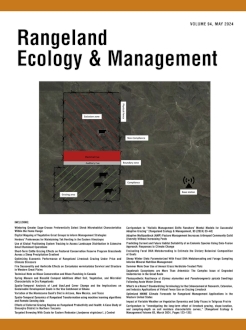Rangelands globally face escalating threats from overgrazing, land conversion, and climate change. This study investigates spatio-temporal rangeland degradation patterns in Pakistan's Bhakkar District, a semiarid region dependent on fragile pastoral ecosystems, over the past four decades at 10-yr intervals (1990, 2000, 2010, 2020). Remote sensing offers a valuable tool for monitoring these vast yet understudied dryland environments. We employed Landsat satellite data and machine learning algorithms to map land cover change and analyze vegetation health indicators. The random forest classifier achieved high accuracy (94%) in delineating six land cover categories–water, built-up, forest, cropland, rangeland, and barren land. Classified rangeland area declined by over 25%, largely due to agricultural expansion. Vegetation indices showed mixed trends, with decreases in enhanced vegetation index but marginal improvement in normalized difference vegetation index. Meanwhile, rising land surface temperatures pointed to increased aridity. These concerning changes underscore the urgent need for conservation policies tailored to community needs through participatory engagement. Rangeland degradation threatens the livelihoods and welfare of pastoral communities reliant on these ecosystems. Integrated solutions centered on adaptation and resilience can promote sustainability in Bhakkar's marginal dryland environments. This study demonstrates the power of satellite monitoring coupled with social research for implementing holistic strategies to address the globally prevalent threat of rangeland disruption.
BioOne.org will be down briefly for maintenance on 12 February 2025 between 18:00-21:00 Pacific Time US. We apologize for any inconvenience.
How to translate text using browser tools
17 May 2024
Spatio-Temporal Dynamics of Rangeland Transformation Using Machine Learning Algorithms and Remote Sensing Data
Ningde Wang,
Iram Naz,
Rana Waqar Aslam,
Abdul Quddoos,
Walid Soufan,
Danish Raza,
Tibra Ishaq,
Bilal Ahmed
ACCESS THE FULL ARTICLE

Rangeland Ecology and Management
Vol. 94 • No. 1
May 2024
Vol. 94 • No. 1
May 2024
ecosystem services
land cover change
machine learning
rangeland degradation
remote sensing




